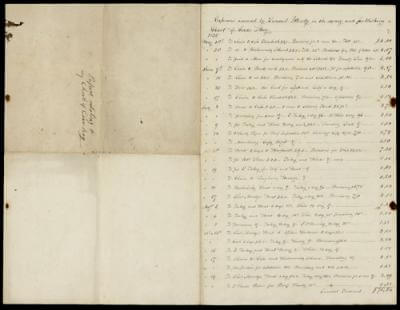EXHIBIT NAVIGATION
For the complete Lemuel Moody Archives Finding Aid please click here.
Chart of Portland Harbour and Islands, and Harbours Adjacent, Extending from the river Kennebeck to Wood Island and Winter Harbour, drawn from the survey of Des Barres with Additions and corrections by L. Moody.

Lemuel Moody, Portland, Maine, 1825-1828
Although the Embargo Act of 1807 prevented European ships from entering U.S. ports for fourteen months, Portland’s harbor remained one of the busiest on the East Coast. That same year, entrepreneur Lemuel Moody successfully pitched his dream to build the Portland Observatory to a group of local investors, and began construction. Using flag signals, Moody used the tower to alert merchants to the arrival of their vessels for an annual subscription of $5.00. Without the observatory, ships could only be seen from the docks after they rounded Spring Point Ledge (marked with Fort Preble on this map, in present-day South Portland). Moody also used his perch at the observatory to make improvements to Joseph Des Barres’ chart of Portland Harbor, giving copies to his subscribers.
Falmouth Harbor [and] Portland Sound

Joseph Des Barres, Frederick Wallet, London, 1776
This is the map Moody used to create his chart of Portland Harbor. When Des Barres published this map, Moody was about 9 years old. A year later, at the height of the American Revolutionary War, Moody served as a waterboy to captains Joseph Pride and John Reed, fueling the young boy’s dream of making a career at sea. At the conclusion of the war, Moody set off to become a ship captain.
Observation of a Comet
Although the stars are still visible from the observatory today, the light pollution from the growing city has diminished their brilliance. This document describes a bright comet Moody observed from the tower.
Longitude of Portland

Lemuel Moody, Portland, Maine, 1821
Much of Moody’s later life was occupied by studying Portland’s position on the East Coast.
Memorandum of an agreement entered into this 30th day on May 1825 between Seward Porter, Lemuel Moody & Geo. Deering on the one part K& D.G. Johnson on the other part…

Lemuel Moody, Portland, Maine 1825
The following directions for Portland Harbor and also for several of the Harbors… Authorities: Lemuel Moody

Lemuel Moody, Portland, Maine, 1829
This was yet another perk for subscribers.
Money paid by Leml. Moody for publishing the chart of Cascobay

Lemuel Moody, Portland, Maine, 1831
Moody paid $497.85 to get his chart published.
[Expense sheet for travel, surveying and creating charts]

Lemuel Moody, Portland, Maine, 1832
Dr. Capt Seward Porter to Lemuel Moody

Lemuel Moody, Portland, Maine, 1835
Many of Moody’s subscribers only needed one or two items, but some, like Dr. Captain Seward Porter, required long lists of charts, directions, and notes.
Thermometrical record for February 1835 at Portland Observatory

Lemuel Moody, Portland, Maine 1835
Memorandum of an agreement… 30th May 1825 between Seward Porter, Lemuel Moody and Geo. Deering… with D. G. Johnson [with an addendum notation by Moody]

Lemuel Moody, Portland, Maine, 1836
Capt. Seward Porter in Acct. with Lemuel Moody for publishing chart of Casco

Lemuel Moody, Portland, Maine, 1836
Expences [sic] incurred by Lemuel Moody in the survey and publishing chart of Casco

Lemuel Moody, Portland, Maine, 1836
Whole number of charts struck off D. G. Johnson… Mr. Allen of Boston… Mr. Cullum of Portland

Lemuel Moody, Portland, Maine, 1836
David G. Johnson was a 19th century painter and engraver from New York. But between 1831 and 1835, he set up shop at 4 Market Square, producing maps of the peninsula for the 1834 city directory and engravings for the Portland Nautical Society.
Account of charts sold and delivered

Lemuel Moody, Portland, Maine, 1836
[Correspondence, 1838- 3 letters from Fellows Wadsworth & Co. to Lemuel Moody and 1 letter from Lemuel Moody to J. Melville Giiliss]

Lemuel Moody, Fellows Wadsworth and Co., Portland, Maine, 1838
The Portland Pilot directions for sailing into Portland, and Harbors adjacent

Lemuel Moody, Portland, Maine, 1890
Calculation of the longitude of Portland by George Blackburn; Calculation of the longitude of Mountjoy by Captain Moody. [Scientific and natural phenomenon]

George Blackburn, Lemuel Moody, Portland, Maine, 1821-1831
